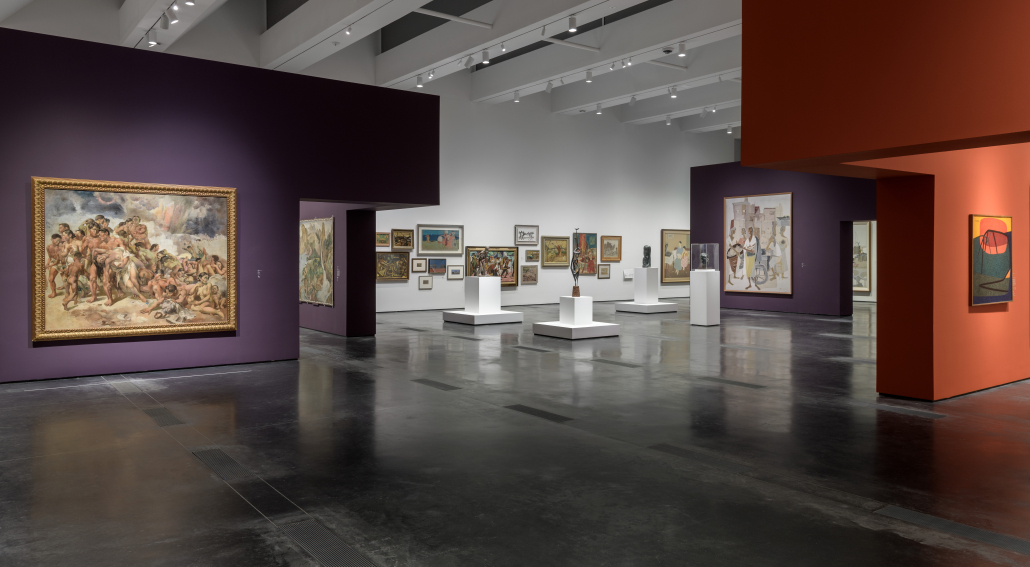LACMA highlights modern Korean art

“The Space Between: The Modern in Korean Art” is now available to visit at the Los Angeles County Museum of Art. The exhibit explore modern Korean art throughout five distinct periods of the 20th century. (Sarah Applegate | Museum Associates/LACMA)
Far too often in the United States, art museums have taken exclusionary attitudes towards typically underrepresented groups. Artists outside of the Western canon go unnoticed, leaving us with an incomplete understanding of the global arts community. Fortunately, this attitude is rapidly changing, with many organizations undergoing new efforts to display pieces originating from all parts of the world. Here in Los Angeles, we get a first-hand look at this shift.
The Los Angeles County Museum of Art officially opened “The Space Between: The Modern in Korean Art” on Sept. 11. A collection of over 130 pieces, the exhibition includes a variety of art mediums, including oils, photographs and sculptures.
Curated by Virginia Moon, LACMA’s assistant curator of Korean art, the collection is carefully arranged to emphasize the stylistic changes resulting from foreign influences in 20th century Korea.
“This project is a rare opportunity to introduce people to the modern art of Korea by looking at the influences that drove its development,” Moon said in the exhibition advisory.
Indeed, the various influences are complex and difficult to talk about. For Korea, the first half of the 20th century was characterized by extortion, colonization and conflict. Nevertheless, the adversity faced by the peninsula’s civilians led to the growth of a new national identity and pride in their homeland. The themes explored by the exhibition have striking relevance, both historically and also to the modern day.
The exhibition is organized into five distinct categories, representing different periods of artistic development. Spanning from 1897 to 1965, the exhibition covers the periods of the Korean Empire, Japanese colonization, the Korean War, the growth of feminism and the decade leading to the contemporary period.
The exhibition’s first section, “Modern Encounter,” begins in 1897 with the establishment of the Korean Empire under the last two kings of the Joseon dynasty. The influx of photography resulting from the governmental change had an impact on the tendencies of Korean painters, becoming absorbed with the concept of intensely exact depictions of real life.
Kim Eunho’s “The Portrait of Emperor Sunjong” perfectly represents the budding enchantment with photography. In the draft portrait, the emperor’s facial features are exquisitely shaded, while his uniform (with clear influences from Western military garb) is outlined in exacting ink strokes. While the final portrait was destroyed in a fire, the draft still demonstrates the nuanced layers of artistic influence in the period of empire.
The next section, “Modern Response,” follows art in Korea during Japanese colonization between 1910 and 1945. Art training, only available through Japan, taught adaptations of Western art. At the same time, photography continued to grow, gaining recognition as a genuine art form.
This section is perhaps the most enthralling of all. Working in styles previously foreign to Korea, artists manipulated the Western techniques for their own purposes, portraying their own identity through the mediums of other people. This fascinating intersection of culture produces incredible artistic statements, such as Lee In-sung’s “Valley in Gyeongju,” a depiction of Korean agriculture with clear Western influence and bold use of color.
“Modern Momentum,” the third section, follows Korean art after World War II and into the Korean War. At this point, the influence of the United States and other Western countries was direct, transmitting cubism, abstraction and expressionism into the peninsula’s art environment.
This section contains a myriad of stunning works, including Kim Whanki’s “Jars and Women,” Lee Soo-auck’s “6.25 War” and Lee Jung-seob’s “Tied People” and “Children.” The two pieces by Lee Jung-seob, scraped onto tinfoil linings from cigarette packs, display the hardships confronting Korean people during the period.
The penultimate section, “The Pageantry of the New Woman (Sinyeoseong) Movement,” centers around the arisal of Korean feminism, particularly pertaining to the growth of educational opportunities. The surge in feminist attitudes was met with resistance from the Confucian-based society— a conflict emblematic of the many clashes in Korean society during this time.
Undoubtedly, the most recognizable and iconic piece of this section is Shin Nakkyun’s portrait of Choi Seunghui. Exemplifying the Sinyeoseong look, the portrait captures the famous entertainer with bobbed hair in a shorter, Western-style dress. Shin’s photograph, the most printed in Korean history, brilliantly captures the rapidly changing societal perceptions of women.
Finally is “Evolving into the Contemporary,” a glimpse into the future of art in a fractured Korean peninsula. The art displayed in this section contains pieces that start to take art to its extreme, replete with all sorts of abstract and contemporary techniques. Korean artists begin to cast off all foreign influences, coming to artistic expressions that were decidedly unique to Korea.
The art contained in this section is arguably the most challenging, yet engaging, of the entire exhibit. An example is Quac Insik’s “Artwork,” a piece created by reconstructing a glass pane that was fractured with a lump of metal. Quac’s experimentation with the boundaries of art mediums represents the liberation of artistic techniques, a stark contrast to the beginning pieces of the exhibition.
Moon’s curation of the pieces invites viewers to come to new conclusions about Korean art and history, while also perhaps encouraging reflection on our time. The 130-piece collection is an excellent demonstration of the “space between” the historical and contemporary Koreas – a powerful experience for all visitors.

